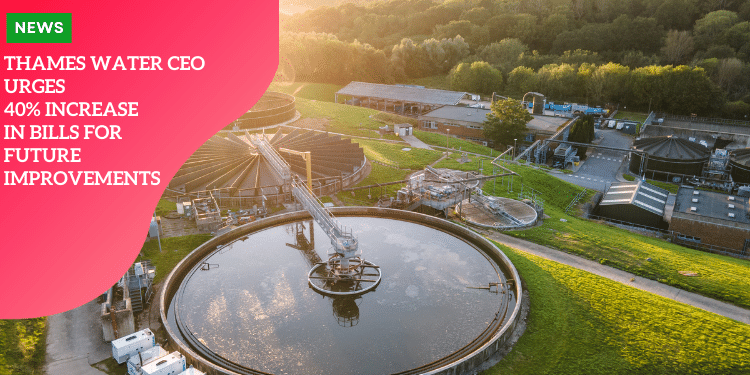Thames Water CEO Urges 40% Increase in Bills for Future Improvements

Introduction
In the realm of water utility management, few announcements can ripple through the public consciousness as profoundly as a proposed surge in customer bills. Thames Water’s CEO has indeed made waves with the call for a significant 40% increase in bills by 2030. This proposal is not merely a number; it’s a reflection of the immense financial and infrastructural pressures facing the UK’s largest water company. Serving an extensive network of 15 million households, the imperative to invest in infrastructure improvements cannot be overstated.
Thames Water finds itself at a crossroads, grappling with a dual challenge: ensuring the long-term sustainability of its operations and meeting the immediate needs of its vast customer base. The financial challenges confronting the company are multifaceted. A hefty debt burden looms large, with a significant portion attributed to past ownership by Macquarie, an Australian infrastructure bank. The debts have swelled to such an extent that they’ve become a straitjacket, constraining the company’s ability to maneuver financially without passing costs onto consumers.
Infrastructure, the backbone of any utility company, stands at the heart of this issue. For Thames Water, the need for investment is not just about maintenance—it’s about transformation. In an era where environmental considerations are paramount, and customer expectations are ever-evolving, the water utility must upgrade its systems to meet these demands. Infrastructure improvements are vital for resilience against future challenges, be they climatic extremes or population growth. This necessity comes with a price tag—one that Thames Water’s CEO suggests should be shared by its customers if the company is to maintain the quality of service and environmental compliance expected of it.
This introduction sets the stage for a deeper exploration into the rationale behind the proposed bill increase, the regulatory and financial hurdles that Thames Water faces, and the broader context of what this means for stakeholders ranging from investors to the average consumer. It’s essential to understand that the company’s trajectory is not just about numbers on a bill but about securing a sustainable future for water services in one of the world’s most dynamic regions.
Rationale Behind the 40% Bill Increase
As we unpack the reasons for Thames Water’s proposed financial strategy, the need for increased investment in infrastructure stands at the forefront. The company’s infrastructure, which is critical to delivering water and sewage services to millions, requires substantial upgrades. Without these improvements, the risk of system failures escalates, potentially leading to interruptions in service and environmental damage. Thames Water CEO Chris Weston outlined that a 40% hike in bills by 2030 would lay the foundation for much-needed investments. The urgency stems from a simple premise: aging pipes, treatment plants, and sewers must be modernized to ensure reliable service and compliance with stringent environmental standards.
Thames Water’s predicament is hardly unique; it mirrors a global trend where utility companies face the mammoth task of overhauling outdated infrastructure. This is no small feat—the costs run into billions and demand long-term financial planning. The implications of ignoring such necessities are dire: not only could there be service disruptions, but there’s also the looming threat of environmental penalties, especially given the increasing instances of sewage spills reported in recent years.
The company’s woes are compounded by the regulatory body, Ofwat’s resistance to significant bill increases. Ofwat insists that Thames Water, despite its financial challenges, must prioritize customers’ interests and operate within the bounds of fairness and affordability. This pushback from the regulator adds another layer of complexity to an already intricate issue. The balancing act between ensuring financial viability and protecting consumer interests is delicate, and finding common ground is proving to be an arduous task.
But why exactly is there a pressing need for such a drastic increase in bills? Shareholder pressure is a driving force behind this move. Investors, including global pension and wealth funds, are reluctant to inject more capital without the prospect of higher returns. In a world where profits dictate movements, the current shareholders’ stance has put Thames Water in a corner. If the company cannot offer an attractive return on investment, it risks losing existing investors and the challenge of attracting new ones becomes even greater.
Looking at the bigger picture, the proposed bill increase isn’t solely about addressing immediate financial needs. It’s also about securing the long-term success of the water utility. Without the necessary funds to invest in upkeep and advancements, Thames Water could fall behind in both service quality and environmental responsibility. The consequences of failing to meet infrastructure requirements extend beyond the company’s balance sheets—they ripple through the environment and touch each customer’s life.
In essence, the call for a 40% bill increase by 2030 is a reflection of the stark reality faced by Thames Water: invest now or pay a heftier price later, both financially and environmentally. As we continue to navigate through the intricacies of this issue, it’s clear that the stakes are high and the path forward is fraught with challenges. However, the necessity for action is undeniable, and the rationale for investment is rooted in a vision for a sustainable and reliable water future.
Challenges in Implementing the Bill Increase
The journey of Thames Water towards securing its financial future has hit choppy waters, not least because of the firm stance taken by Ofwat. This regulatory body, whose approval is essential for any rate hikes to take effect, has thus far been unyielding in their resistance to substantial bill increases. So, what does this mean for Thames Water, and how might they navigate these troubled tides?
Examination of Ofwat’s Resistance to Substantial Bill Hikes
Understanding the regulator’s position is crucial. Ofwat’s pushback stems from a commitment to protect consumers from sharp price rises, which could have significant socioeconomic impacts. Their stance is supported by the assertion that even without additional capital, Thames Water can maintain day-to-day operations for up to 18 months, as per information revealed by sources close to the regulatory body. This resistance poses a stark dilemma: how can Thames Water reconcile the need for investment in infrastructure with the regulator’s duty to keep bills fair for customers?
Impact of Regulatory Constraints on Thames Water’s Financial Decisions
Regulatory constraints are not just a hurdle; they shape the financial strategy of utility companies like Thames Water. With Ofwat standing firm, Thames Water’s proposed increase in customer bills to fund much-needed infrastructure improvements is not an immediate option. This leaves the company in a precarious position, needing to find alternative ways to close the investment gap without contravening Ofwat’s directives. The tightrope walk between funding improvements and maintaining customer affordability is delicate and fraught with potential falls.
Exploration of Potential Strategies for Overcoming Investment Gaps
Where does Thames Water go from here? One avenue may be the pursuit of new investors to inject fresh capital into the business, as suggested by the firm’s own turnaround plan. However, the current shareholders, including international pension and wealth funds, demand a return on their investment—a return that hinges on the ability to raise bills. The challenge is to make the company an attractive proposition to potential investors under the specter of constrained bill increases. Fortunately, there are other strategies that can be considered, such as operational efficiencies, cost-cutting measures, and innovative technologies that could potentially bridge the financial shortfall without overburdening consumers.
Innovation and efficiency are more than mere buzzwords in this context; they represent tangible lifelines that could help Thames Water maintain its infrastructure without a drastic bill increase. This might include adopting advanced water conservation techniques or investing in renewable energy sources to power facilities, thus reducing operational costs in the long-term. Another strategy could involve renegotiating debt terms to ease the financial burden of interest payments. Ultimately, each of these paths requires careful consideration and a collaborative effort between Thames Water, its investors, and Ofwat to ensure sustainability and service quality.
Stakeholder Perspectives and Responses
When it comes to the proposed 40% increase in customer bills by Thames Water, stakeholders are bound to have varied reactions. Let’s delve into the intricacies of these responses, starting with the investors. Investors are at the heart of the discussion, their demands for higher returns fueling the need for increased capital injection into Thames Water. The company’s substantial debt, detailed by BBC, signals a pressing need for financial overhaul. Shareholders, who include global pension and wealth funds, have expressed reluctance to provide additional funds without the assurance of bill hikes [source: Thames Water boss says bills need to rise by 40%.docx].
Meanwhile, criticisms faced by Thames Water are not just financial but also environmental and operational. The firm has been spotlighted for discharging billions of litres of sewage into rivers, an environmentally hazardous practice that has drawn ire from various quarters. Customer service issues also plague the utility, with reports suggesting that certain regions, including the constituency of Chancellor Jeremy Hunt, have experienced substandard services [source: Thames Water boss says bills need to rise by 40%.docx].
Given the complexities, the conversation turns to contingency plans by the UK government and Ofwat’s assessment. The government, acutely aware of Thames Water’s critical role in serving 15 million households, has prepared to take over should the company collapse. Nonetheless, Ofwat, the regulatory body, has confidence in Thames Water’s ability to operate independently for the next 18 months without immediate nationalization, citing the firm’s current revenue as sufficient for short-term operations [source: Thames Water boss says bills need to rise by 40%.docx].
From an investment standpoint, shareholders’ push for profitability is understood yet fraught with tension, as regulatory bodies and consumer advocates resist bill increases. This dichotomy presents a challenging balancing act for Thames Water, which must appease its investors while adhering to Ofwat’s mandate to be “fair to bill payers” and improve environmental performance and customer service [source: Thames Water boss says bills need to rise by 40%.docx].
As we reflect on the previous section on challenges in implementing the bill increase, we see that innovation, collaboration, and perhaps new investment are potential solutions to address the infrastructure issues without overburdening customers. It’s a complex puzzle that Thames Water must solve, navigating investor expectations, regulatory compliance, and the public’s best interests.
Future Prospects and Strategies
As we navigate the waters of Thames Water’s financial conundrum, it’s essential to ponder over their strategies for sailing towards calmer seas. One avenue under consideration is the possibility of seeking new investors. The need for fresh capital injection looms large as current shareholders, including an array of international pension funds and wealth funds, appear hesitant to dive deeper into their pockets without the prospect of bill increases to buoy their returns. The looming question is whether these new investors will be lured by the promise of future profitability or deterred by the company’s substantial debt burden and the regulatory pushback on price hikes.
Moving on to the company’s focus on environmental sustainability and customer satisfaction, Thames Water stands at a crossroads. They are under intense scrutiny for environmental violations, specifically the discharge of billions of liters of sewage into the Thames. This tarnishes their image and calls for a stringent reassessment of operational practices. Enhancing customer service also emerges as a critical area, with public sentiment demanding improvements. How Thames Water tends to these concerns while navigating their financial constraints will play a crucial role in shaping public perception and regulatory compliance.
The long-term viability and success of Thames Water amidst these financial challenges cannot only be a matter of balance sheets and investment returns. It will require a holistic approach that considers regulatory frameworks, environmental stewardship, and community trust. It’s a delicate dance between satisfying shareholder expectations and meeting Ofwat’s standards, which are intrinsically tied to public interest. With UK government contingency plans in place, there’s an underlying message that while the company’s operations might continue uninterrupted for a period, sustainable solutions need to be found – and quickly.
Conclusion and Call-to-Action
In light of the discussions presented in this blog post, we’ve unpacked the thorny issue surrounding Thames Water CEO’s proposal for a 40% increase in customer bills. This hike, deemed necessary for infrastructure improvements, has sparked considerable debate among stakeholders, from investors to customers and regulatory bodies. Let’s recap the key takeaways before considering our collective role in this unfolding narrative.
Thames Water finds itself at a crossroads, with financial pressures mounting and shareholder expectations rising. As the largest water utility in the UK, serving around 15 million households, the company’s struggle to balance investment needs with fair customer pricing is symptomatic of a larger, sector-wide challenge. Ofwat, the regulator, remains steadfast in its commitment to protect consumers from steep bill increases, leaving Thames Water to navigate an investment gap that could potentially stretch the firm’s financial resilience.
As informed citizens, it behooves us to stay abreast of developments within Thames Water. The decisions made by this utility company do not exist in isolation; they reflect broader economic, environmental, and social issues. Understanding the nuances of these challenges can empower us to engage in meaningful dialogue, advocate for responsible corporate behavior, and hold regulatory bodies accountable for protecting public interest.
Reflecting on the broader implications, the saga of Thames Water underscores the delicate act of balancing financial sustainability with regulatory compliance. It is a dance between ensuring adequate capital for infrastructural upgrades and maintaining affordable services for the population. This tension speaks to the heart of public utility management and raises pertinent questions about the future landscape of water services in the UK and beyond.
As we consider the path ahead, let’s remember that the infrastructure underpinning our water services is not just a matter of economics; it is vital to public health, environmental stewardship, and the quality of life for millions. The discourse around Thames Water’s bill increase proposal serves as a reminder of our shared responsibility in fostering a sustainable future.
So, what can you do? Stay informed, engage with your local representatives, and participate in community discussions on the subject. Whether you’re directly affected by Thames Water’s services or simply concerned about the precedent it sets, your voice matters. Together, through vigilant oversight and active participation, we can influence the course of our utilities and ensure that they serve the public good effectively and equitably.





